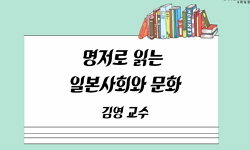This paper will examine young characters in the works of Gakiya Miu and Murata Sayaka, for the better understanding of the young generation in modern Japanese society. Investigating how the youth is portrayed in the novels of the two authors will give...
http://chineseinput.net/에서 pinyin(병음)방식으로 중국어를 변환할 수 있습니다.
변환된 중국어를 복사하여 사용하시면 됩니다.
- 中文 을 입력하시려면 zhongwen을 입력하시고 space를누르시면됩니다.
- 北京 을 입력하시려면 beijing을 입력하시고 space를 누르시면 됩니다.

현대 일본 사회의 청년 캐릭터 고찰 - 가키야 미우(垣谷美雨), 무라타 사야카(村田沙耶香)의 작품을 중심으로 = A study of the characters of the young generation in modern Japanese society- Based on the works of Gakiya Miu and Murata Sayaka
한글로보기https://www.riss.kr/link?id=A108402808
-
저자
신현선 (전북대학교)

- 발행기관
- 학술지명
- 권호사항
-
발행연도
2022
-
작성언어
Korean
-
주제어
Japanese society ; Gap society ; Young generation ; Temporary positions ; Rage ; Mutant creatures ; 일본사회 ; 격차사회 ; 청년 캐릭터 ; 비정규직 ; 분노 ; 변용 생물
-
등재정보
KCI등재
-
자료형태
학술저널
-
수록면
289-306(18쪽)
- 제공처
-
0
상세조회 -
0
다운로드
부가정보
다국어 초록 (Multilingual Abstract)
This paper will examine young characters in the works of Gakiya Miu and Murata Sayaka, for the better understanding of the young generation in modern Japanese society. Investigating how the youth is portrayed in the novels of the two authors will give an understanding of how the youth is represented and the structure of modern Japanese society. Also, we’ll be able to identify discrimination and gaps inherent in Japanese society and we’ll see how the young generation accepts these difficulties in their lives.
The younger generation in Japan live with excessive competition, job failure, temporary positions, and also suffer from anxiety about the future. Gakiya Miu and Murata Sayaka deal with both universal and personal problems facing the younger generation, such as marriage, work-related issues, and human relationships in their novels. Therefore, these two authors raise questions about the problems facing today’s Japanese society such as an aging population, youth unemployment, and an increase in single person households.
This paper will analyze the Japanese youth through the characters who live in a ‘gap society’ - unlike the previous generation. Additionally, we’ll also examine the pattern of how these young characters turn into ‘mutant creatures who do not rage’ as they adapt to the ‘gap society’.
The works of Gakiya Miu and Murata Sayaka realistically portray the lives of a young generation who suffer a harsh reality. We’ll be able to understand how the young Japanese feel about their lives by looking at the expression of their agonies and perceptions. The problem of understanding the young generation will serve as an opportunity to demonstrate how conditions of life are changing to ensure survival in a multi-layered life.
1 塩野七生, "「會社人間」から「コンビニ人間」へ?" 文藝春秋社 96-, 2016
2 무라타 사야카, "편의점인간" 살림 2018
3 정근하, "청년층 무이력 기간 장기화 현상연구(2) 일본편 -일본의 사회문화적 인식을 중심으로-" 한국일본문화학회 (63) : 327-351, 2014
4 세계일보, "중년 캥거루족"
5 SASANO MISAE, "전후 일본 청년 세대 담론과 생애 변화의 세대별 분석 – 삶의 제도화, 표준화, 그리고 다양화 –" 일본연구소 (72) : 37-64, 2017
6 한국일보, "일본의 젊은이들은 왜 소비를 멀리할까?"
7 이인수 ; 야마모토 고헤이, "일본 청년의 히키고모리 경험에 관한 현상학적 연구" 한국가족치료학회 28 (28): 67-84, 2020
8 신현선, "일본 사회의 매뉴얼과 ‘보통’의 삶에 대한 고찰 - 편의점 인간 을 통해 본 사토리 세대의 고민" 동북아시아문화학회 1 (1): 145-163, 2022
9 김영, "일본 블랙기업 노무관리 연구: 청년 노동자 갈아서 버리기(使い潰し)의 기법과 확산배경" 한국산업노동학회 22 (22): 243-282, 2016
10 한국출판마케팅연구소, "소확행 이후의 출판 트렌드"
1 塩野七生, "「會社人間」から「コンビニ人間」へ?" 文藝春秋社 96-, 2016
2 무라타 사야카, "편의점인간" 살림 2018
3 정근하, "청년층 무이력 기간 장기화 현상연구(2) 일본편 -일본의 사회문화적 인식을 중심으로-" 한국일본문화학회 (63) : 327-351, 2014
4 세계일보, "중년 캥거루족"
5 SASANO MISAE, "전후 일본 청년 세대 담론과 생애 변화의 세대별 분석 – 삶의 제도화, 표준화, 그리고 다양화 –" 일본연구소 (72) : 37-64, 2017
6 한국일보, "일본의 젊은이들은 왜 소비를 멀리할까?"
7 이인수 ; 야마모토 고헤이, "일본 청년의 히키고모리 경험에 관한 현상학적 연구" 한국가족치료학회 28 (28): 67-84, 2020
8 신현선, "일본 사회의 매뉴얼과 ‘보통’의 삶에 대한 고찰 - 편의점 인간 을 통해 본 사토리 세대의 고민" 동북아시아문화학회 1 (1): 145-163, 2022
9 김영, "일본 블랙기업 노무관리 연구: 청년 노동자 갈아서 버리기(使い潰し)의 기법과 확산배경" 한국산업노동학회 22 (22): 243-282, 2016
10 한국출판마케팅연구소, "소확행 이후의 출판 트렌드"
11 은석 ; 안승재 ; 함선유 ; 홍백의, "세대 차이인가, 계층 차이인가?: 한국과 일본의 가족가치관 차이를 중심으로" 아시아연구소 8 (8): 41-74, 2018
12 가키야 미우, "서른두 살 여자, 혼자 살 만합니다" 지금이책 2019
13 김태경, "분노사회 일본―2000년대 이후 일본 사회・문화 분석―" 일본연구소 54 : 151-169, 2018
14 무라타 사야카, "무성교실" 하빌리스 2022
15 구마시로 도루, "로스트 제너레이션 심리학" 퍼블리싱 컴퍼니 클 50-, 2014
16 김지영, "격차문제에 대한 일본 사회의 대응과 그 특징" 일본연구소 14 (14): 78-99, 2022
17 垣谷美雨, "農ガ-ル,農ライフ" 祥傳社 2016
18 佐藤康智, "評論 水槽としてのコンビニー『コンビニ人間』論" 178-, 2016
19 土居充夫, "現代日本における新自由主義化" 大阪經大學會 58 (58): 88-, 2008
20 朝日新聞, "怒るべき時、それは今 絶対的権力は絶対に腐敗する"
21 矢野千晶, "差の消滅:村田沙耶香「授乳」から『コンビニ人間』まで" 29 : 136-, 2017
22 村田沙耶香, "丸の內魔法少女ミラクリ-ナ" KADOKAWA 2020
23 垣谷美雨, "七十歲死亡法案,可決" 幻冬舍 2015
24 村田沙耶香, "コンビニ人間)" 文藝春秋 2016
25 매일경제, "“연애․성생활은 사치” 일본 이대남 40% 초식 넘어 절식남된 이유"
26 NHK NEWS WEB, "“親ガチャ” 話題のことばをぶつけてみたら"
27 매일경제, "‘한국인보다 가난한 일본인?’ 그들 월급이 20년 넘게 그대로인 이유"
28 양준호, "‘격차사회’ 일본과 빈곤층 재생산: 고용․소득 격차에 의한 저축․교육 격차의 확대를 중심으로" 서울대학교 일본연구소 4 : 18-47, 2011
29 "https://www3.nhk.or.jp/news/html/20210924/k10013272271000.html?utm_int=news_contents_netnewsup_002"
30 가키야 미우, "70세 사망법안, 가결" 왼쪽주머니 2018
31 양아람 ; 이행선, "2010년대 한국과 일본의 편의점, 점원, 사회, 문학 - 무라타 사야카(村田沙耶香)의 『편의점 인간』과 박영란의 『편의점 가는 기분』" 한국학연구소 (63) : 195-230, 2017
동일학술지(권/호) 다른 논문
-
- 동북아시아문화학회
- 王涛
- 2022
- KCI등재
-
- 동북아시아문화학회
- 이명아
- 2022
- KCI등재
-
- 동북아시아문화학회
- 张庆
- 2022
- KCI등재
-
- 동북아시아문화학회
- 김현숙
- 2022
- KCI등재




 KCI
KCI DBpia
DBpia







